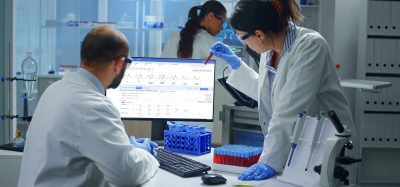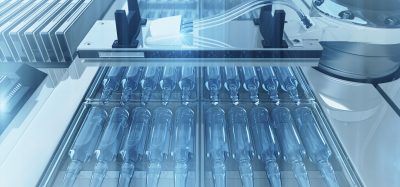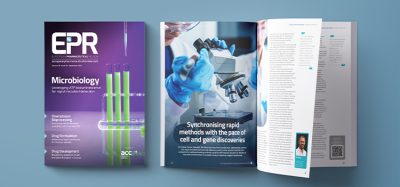PAT and design science
Posted: 23 May 2007 | | No comments yet
Process analytical technology (PAT) and mechanical design science are interconnected; this article describes how a well-established design modelling approach; the Hubka-Eder model, is applied to the concepts of PAT and quality by design (QBD). The model connects PAT with quality management concepts as defined for PAT by the ICH guidelines for quality issues. Examples are taken from biopharmaceutical applications, but these are also applicable to other active pharmaceutical ingredients (API). Benefits of using a conceptual design modelling approach in PAT and related subjects are discussed and suggested as a complementary functionality analysis tool in PAT and quality design of pharmaceutical processes.
Process analytical technology (PAT) and mechanical design science are interconnected; this article describes how a well-established design modelling approach; the Hubka-Eder model, is applied to the concepts of PAT and quality by design (QBD). The model connects PAT with quality management concepts as defined for PAT by the ICH guidelines for quality issues. Examples are taken from biopharmaceutical applications, but these are also applicable to other active pharmaceutical ingredients (API). Benefits of using a conceptual design modelling approach in PAT and related subjects are discussed and suggested as a complementary functionality analysis tool in PAT and quality design of pharmaceutical processes.
Process analytical technology (PAT) and mechanical design science are interconnected; this article describes how a well-established design modelling approach; the Hubka-Eder model, is applied to the concepts of PAT and quality by design (QBD). The model connects PAT with quality management concepts as defined for PAT by the ICH guidelines for quality issues. Examples are taken from biopharmaceutical applications, but these are also applicable to other active pharmaceutical ingredients (API). Benefits of using a conceptual design modelling approach in PAT and related subjects are discussed and suggested as a complementary functionality analysis tool in PAT and quality design of pharmaceutical processes.
Process analytical technology (PAT) and design science are interrelated; although the leading idea of PAT is to develop quality by design in the pharmaceutical manufacturing process1. Surprisingly, few attempts have been made to apply fundamental design theory in keeping with the routine practices of other engineering disciplines.
The concept of PAT is currently summarised as a system for designing, analysing, and controlling pharmaceutical manufacture through timely measurements (i.e. during processing) of critical quality and performance attributes for incoming and intermediate materials and of the process operation itself; with the goal of ensuring the final product quality.
It is often understood that analytical technology in PAT should be viewed broadly and include chemical, physical, microbiological, mathematical, and risk analysis conducted in an integrated manner. Thus, PAT requires significant inter-scientific understanding. By this, many current and new tools must be made available that can enable scientific, risk-managed pharmaceutical development, manufacture and quality assurance. These tools, when used as a system, can provide effective and efficient means for acquiring information to facilitate process under–standing, develop risk-mitigation strategies, attain continuous improvement, and share knowledge and other information.
Appropriate tools to achieve this objective as stated by the FDA:
- Multivariate data acquisition and analysis
- Modern process analysers or process analytical chemistry
- Process and endpoint monitoring and control
- Continuous improvement and knowledge management
An appropriate combination of some, or all, of these tools may be applicable to a single-unit operation, or to an entire manufacturing process and its quality assurance. It is frequently the case that adjacent quality concepts for pharmaceutical quality systems such as the International Conference on Harmonization (ICH) guidelines are mentioned in parallel including risk analysis, quality management schedules, testing principles and Good Manufacturing Practice2-6. These ideas, guidance and rules should be merged with existing, often very well established process engineering principles emanating from basic pharmaceutical technology, chemical process engineering, analytical chemistry and biotechnology. This wide range of scientific and technology know-how easily becomes overwhelming and contradictive; in particular proving extremely hard to efficiently overview and handle for design tasks that have purely economical and quality-related objectives and needs.
In this article it is suggested that more fundamental conceptual design reasoning could be implemented in the current PAT and QBD ambitions with the single purpose of avoiding inefficient solutions and unnecessary actions when trying to develop quality in an economical manner.
Design theory
Many conceptual models have been presented in design theory7-10. Of these, much attention has been given to the Hubka-Eder model approach11-13 due to its generality and applicability to any technical system for manufacture and production. In spite of that, almost all applications are found in mechanical and electrical engineering applications and combinations thereof, so-called mechatronics14-15.
The Hubka-Eder model for a manufacturing process (Figure 1) is built around the transformation process (TrP) and its applied technologies (Tg) to transform the inputs, being the sums of operands (ΣOd1), i.e. the raw materials, properties (ΣPr1) and secondary components (ΣSecIn), into outputs (ΣOd2, ΣsPr2, and ΣSecOut). The model then analyses all effects that are exerted on the TrP and which are part of it. These include the technical systems involved (ΣTS), all information systems (ΣIS) and all management and goal-setting systems (™M&GS). Thus, processing machines such as blending tanks, extruders and heat exchangers are examples of technical systems that transform chemical or biological reactants and intermediates by causing reaction or separation without being transformed themselves. Data collection systems such as data processing software and batch reporting procedures interact with the ΣTS, while rules such as GMP and operational SOPs for the TrP act to attain set production goals in the ΣM&GS as well as quality criteria and productivity goals.
The purpose of the design model is to carry out a systematic investigation of effects in all steps involved. Figure 1 illustrates the top level of the systems approach; a more detailed scheme on a second or third level would elucidate in a much more thorough and informative way the multitude of interacting effects. This analysis should then lead to the identification of alternative design solutions. The systematic approach aims to avert early fixations with un-reflected solutions.
The Hubka-Eder model has recently been adapted to biotechnology products and systems by adding a separate biological systems entity; ΣBS, to the design concept with the objective of improving the functional analysis of the cross-interactions between the participating subsystems of varying origin16. This leads to better analysis of complex biotechnology machines such as bioreactors and protein separation systems that exploit the transformation capacity of biological systems.
Adaptation of conceptual design to a pharmaceutical manufacturing process
Could conceptual design modelling be applied to a pharmaceutical manufacturing process? In pharmaceutical process engineering we are used to modelling technical systems in the form of unit operations17-19.
The flow-sheet for a general biopharmaceutical manufacturing process is shown in Figure 2A with upstream, bioreaction, downstream and formulation for such unit operations. For example; the outline of the process is close to manufacture of growth hormone or insulin in recombinant organisms. Manufacturing processes for other active pharmaceutical ingredients follow the main structure of the figure although unit operations are varied and adapted to the reaction chemistry and requirements of the actual substance processed. The flow-sheet adheres to the traditional method of analysing a chemical process, including pharmaceutical and biotechnology-related processes, where inlet raw materials, output products and side-products are possible to identify in connection to the sequence of upstream and downstream unit operations17-19. This basic process flow-sheet has an obvious placement in the conceptual design model outlined above as the transformation process of input operands into output operands and, for some of the secondary inputs and outputs, i.e. the side-products and other additions and reagents consumed in the process. What is not there thus far are the machines of the technical systems, our unit operations, since these are not transformed but remain as effect-creating tools for the process; neither the transformations of properties are visible, which are those that PAT aims to identify. In this modular view, the extension to a biological systems entity16 highlights the complexity introduced by biological conversions that take place in biotechnology-related pharmaceutical manufacture. The justification for analysis of the participating biological systems – e.g. a recombinant host cell expressing a pharmaceutical protein that is being transformed in the cellular machinery into main products; being the acceptable molecular forms of the protein in the final product formulation (i.e. output operands), and side-products, such as clipped forms or oxidized forms (i.e. residual secondary outputs). Thus, the biological systems of the cell are considered as subsystems, a sort of biological technical machine (ΣBSrecombinant cell) that performs certain biological transformations, a well-known concept in genomics, proteomics and transcriptomics. Other biological systems may also be included, such as cell banking and pre or post-processing enzymes. Furthermore, it may also be relevant to consider human operators of the systems.
The technical systems are divided into those carrying out the steps in the transformation process (in the flow-sheet in Figure 2A sterilization units, bioreactors, homogenizer, and chromatography separation units), and those systems required for analysing the properties of the operands (intermediate and final product molecules, and those that analyse process-related properties). This follows the definitions in the ICH harmonised guidelines for testing: Q6A2 for chemical substances and Q6B for biologics3. For biological product analysis, procedures by now well-known Mandenius20 and Garnick21 encompass both manual and automatic methods.
In Figure 2B these methods are collected as ΣTSPAT since they are to be considered as the enabling technologies in the PAT view as expressed in the FDA guidance1. However, other important parts of PAT are referred to as information systems (ΣISPAT), having in mind that chemometrics, multivariate methods, automatic control and statistical process control methods are, in the mathematical sense, intellectual knowledge systems to be implemented in software. Information tools and systems are key methods in PAT1.
Management and goal systems (™M&GS) are needed in every industrial manufacturing process. Here, management systems especially cover process operations controlled by batch protocols, SOPs and GMP rules4. Goal systems are connected to design space identification5 with boundaries implemented in quality system and risk management6.
The active environment
The conceptual design model takes special precautions to investigate influences from an active environment; this impact is familiar due to daily experience. Uncontrollable environmental factors also include unknown biological variations which cannot be obtained, at least at present, in mathematical modelling whilst causes are not understood. These are, on the other hand, one of the main motivations for performing PAT.
As indicated in Figure 2B, the final drafting is to depict the interaction pathways. Mainly, it is about identifying the existence and direction of effects, some being very obvious and others requiring deeper analysis, especially if we continue to elaborate on the chart by a further subdivision of units, instruments, tools, rules and goals. This will result in an extensive network of sometimes unexpected interactive effects which should be evaluated, compared with alternative design solutions and ranked by quality and operative effects.
Analysis of effects
Seen from the perspective of the management and goal systems, these should exert effects on how to operate the technical systems, ΣTSunit operations as well as ΣTSPAT, so that the systems transform the raw materials into products that fulfil defined ranges of the quality attributes. The ΣM&GS exert their effects based on a risk management process including identification, analysis, evaluation, reduction and acceptance of risks in the manufacturing process as defined in ICH guideline Q94 which results in instructions to the systems that should effect and correct the transformation process.
However, the risk management process must be based on information and that is also the role of PAT, in the shape of analytical methods and instruments as well as data analysis systems such as chemometric methods, statistical process control and multivariate analysis. Thereby, ΣISPAT and ΣTSPAT also exert effects on risk management.
The interrelations between PAT, IS and M&GS are also apparent when defining the design space, i.e. the multidimensional combination and interaction of input variables (e.g. material attributes) and process parameters that have been demonstrated to provide assurance of quality5. Here, chemometrics methods such as factorial design and design of experiments should be utilised – methodologies encompassed in the ΣISPAT. The risk management process, based on interactions with the information systems and methods that interact with the transformation process through technical systems, should set the accepted control space and effectuate control algorithms and technical systems of the unit operations to realise a closed loop between process parameters and quality attributes.
In biotechnology-related pharmaceutical processes, the interactions with the biological systems are integrated and certainly require deeper analysis. In particular, the quality attributes caused and controlled by the biological system(s)21,22 must be circuits in the loop and defined in the design space about the way in which the process- and product-related properties are transformed3.
Functional and anatomic analysis of PAT
A major purpose of conceptual design modelling is to carry out a comparative functional structure and anatomic structure analysis13.
For the traditional unit operation process flow-sheet, a parallel sequential network showing the achievements by the units on the raw materials and other input components would be close to the functional structure diagram of a conceptual design solution (Figure 3A) with the physical apparatuses of the unit operations at a sufficient level of detail to represent the anatomic structure diagram (Figure 3B). In the anatomic structure diagram, the main focus is the optimisation of the units’ individual design on the level of operational parameters, such as impeller speed or space velocity. The latter is the common form, while the former is the most useful when analysing design alternatives and, probably, when designing PAT systems. Having this functional-anatomic parallelism as a description of the technical systems of unit operations (ΣTSunit operation) in relation to the transformation process, ensures that it is easy to realise a similar parallel can be described for the PAT functionality. The anatomy of the PAT tools should particularly be analysed in relation to Σ Properties in and out of the transformation process. Figure 3C shows a selection of functions for PAT and Figure 3D the anatomic structure of the selected functions.
The type of questions that could be generated from this analysis could be similar to the following:
- How will the design space be affected by other organisms that are capable of performing the same biological functions (cellular conversions)?
- How will a new algorithm affect the function of existing on-line sensor devices, and how will that information affect the function of the technical systems for various unit operations when transforming the raw materials?
- How will a new unit operation with the extended functionality of separating cells generate new requirements of the existing monitoring and control system, and how will the risk management system respond to it?
Again, the purpose of the modelling exercise is to generate new design solutions that bring more appropriate functionality and make it easier to compare alternative design options; iteration with analysis of effects then becomes rewarding.
Conclusion
Current regulatory issues, manufacturing principles, practice around process analytical technology and quality by design tend to divert process science towards new directions and concepts. Differences in scientific and engineering backgrounds, as well as ways to describe systems sometimes disguise important effects and interconnections of new ideas and changes.
To counteract this tendency, this article has suggested taking advantage of experiences from another scientific area – conceptual design science as applied in the mechanical manufacturing industry. Conceptual design has as its fundamental approach to separate functions; means and product objectives in manufacturing processes with the purpose of facilitating the analysis of effects and consequences at an early stage; this is no different within pharmaceutical manufacture.
In one of the best-known models, the Hubka-Eder theory, the perspective is different from the traditional view applied in pharmaceutical and chemical processing founded in unit operations.
This perspective may fit well in the framework of PAT and quality by design for pharmaceutical manufacturing whilst having significant use as an additional tool for quality design work.
This article has briefly outlined these possibilities; it should not be regarded as a replacement methodology but as a tool for which the main purpose is to complement, and thereby contribute to understanding as well as efficiency and reliability.
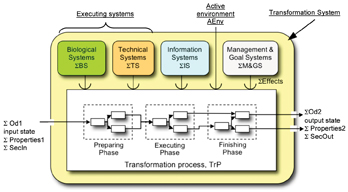

Figure 1: An extended Hubka-Eder model for a technical system showing the interrelations between input operands and properties, transformation processes, and outputs with interacting technical, biological, information and management and goal systems. Inputs are indicated by “1” and outputs by “2”
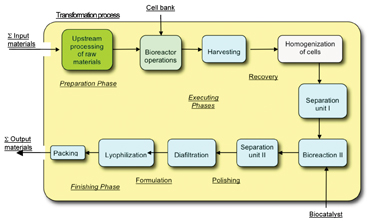

Figure 2A: A traditional process engineering flow-sheet depiction of a typical bioprocess for biopharmaceutical manufacture with unit operations for preprocessing, (bio)reaction, separation and final product formulation
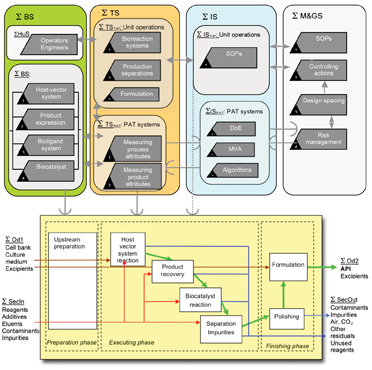

Figure 2B: The traditional flow-sheet integrated in a Hubka-Eder model relating the chemical/biological transformation steps into a collection of functional technical subsystems (Σ TSunit operations) for unit operations, as in A, and PAT related technical systems (Σ TSPAT), with information systems and methods for PAT (Σ ISPAT) and other manufacturing management and goal systems (Σ M&GS) including SOPs, GMP rules, and risk analysis and design space concepts
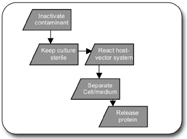

Figure 3A: The bioprocess unit operations in a functional view


Figure 3B: The same operations in an anatomic view
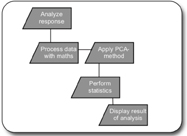

Figure 3C: PAT methods in a functional view
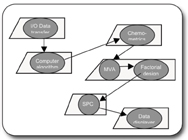

Figure 3D: The same PAT methods in an anatomic view
Acknowledgement
The authors thank VINNOVA for valuable financial support.
References
- Federal Drug and Food Administration (USA) Centre for drug administration and research (2004) Guidance for industry, process analytical technology, a framework for innovative pharmaceutical development, manufacturing and quality assurance, FDA 2004.
- International conference on harmonization of technical requirements for registration of pharmaceuticals for human use (1999). ICH harmonized tripartite guideline for specifications, test procedures and acceptance criteria for chemical substances. Document ICH Q6A.
- International conference on harmonization of technical requirements for registration of pharmaceuticals for human use (1999). ICH harmonized tripartite guideline for specifications, test procedures and acceptance criteria for biotechnological/biological products. Document ICH Q6B.
- International conference on harmonization of technical requirements for registration of pharmaceuticals for human use (2000) ICH harmonized tripartite guideline for good manufacturing practice (GMP) for active pharmaceutical ingredients. Document ICH Q7.
- International conference on harmonization of technical requirements for registration of pharmaceuticals for human use (2005) ICH harmonized tripartite guideline for pharmaceutical development. Document ICH Q8.
- International conference on harmonization of technical requirements for registration of pharmaceuticals for human use (2005) ICH harmonized tripartite guideline for quality risk management. Document ICH Q9
- Pahl G, Beitz W (1996) Engineering design, a systematic approach, Springer Verlag, Berlin.
- Roozenburg N F M, Eekels J (1996) Product design: fundamentals and methods, John Wiley & Sons, Chichester.
- Ullman DG (2003) The mechanical design process, 3rd edition, McGraw-Hill, New York.
- Ulrich KT, Eppinger SD (2004) Product design and development, 3rd edition, McGraw-Hill, New York, 2004.
- Hubka V, Eder WE (1988) Theory of technical systems, a total concept theory for engineering design, Springer Verlag, Berlin.
- Hubka V, Eder WE (1992) Engineering design, general procedural model of engineering design, Heurista, Zürich.
- Hubka V, Eder WE (1996) Design science, Springer Verlag, Berlin.
- Bradley DA, Loader AJ, Burd NC, Dawson D (1991) Mechatronics, electronics in products and processes, Chapman and Hall, London, 1991.
- Mahalik N P (2003) Mechatronics principles, concepts and applications, Tata McGraw-Hill, India.
- Derelöv M, Detterfelt J, Björkman M, Mandenius CF (2007) Engineering design methodology for bio-mechatronic products. Submitted.
- Atkinson B, Mavituna F (1991) Biochemical engineering and biotechnology handbook, 2nd edition, Stockton Press, New York.
- Petrides D P (2003) Bioprocess design, in Bioseparation science and engineering (Eds. Harrison R G, Todd P, Rudge S R, Petrides D P), Oxford University Press, Oxford.
- Doran P (1995) Bioprocess engineering principles, Academic Press, London.
- Mandenius CF (2006) PAT in Biotechnology, Eur Pharm Rev 11, 69-76.
- Garnick RL, Ross MJ, Baffi RA (1991) Characterization of proteins from recombinant DNA manufacture, in Drug biotechnology regulation, scientific basis and practice (Eds. Y-Y Chiu. J L Gueriguian), Marcel Dekker Inc, New York.



